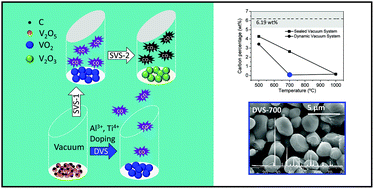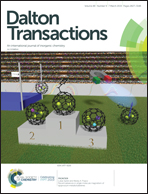Carbon-reduction as an easy route for the synthesis of VO2 (M1) and further Al, Ti doping†
Abstract
A low-cost and facile method to synthesize highly crystallized VO2 (M1) particles is proposed, using carbon black as the reducing agent mixed with V2O5 nanopowders comparing two types of vacuum systems for the thermal activation. In a sealed vacuum system, CO gas is generated in the first reductive step, and continues to reduce the new born VO2, until all the V (+4) is reduced to V (+3), resulting in V2O3 formation at 1000 °C. In contrast, in a dynamic vacuum system, CO gas is ejected through pumping as soon as it is generated, leading to the formation of pure VO2 (M1) at high temperatures (i.e. in the range 700 °C ≤ T ≤ 1000 °C). The evolution of the carbon content, determined by CHNS, of each sample versus the synthesis conditions, namely temperature and type of vacuum system, confirms that the transformation of V (+5) into V (+4) or V (+3) can be controlled. The characterization of the morphologies and crystal structures of two synthesized VO2 (M1) at 700 °C and 1000 °C shows the possibility to tune the crystallite size from 1.8 to more than 5 μm, with a uniform size distribution and highly crystallized powders. High purity VO2 (M1) leads to strong physical properties illustrated by a high latent energy (∼55 J g−1) during the phase transition obtained from DSC as well as high resistivity changes. In addition, with this method, dopants such as Ti4+ or Al3+ can be successfully introduced into VO2 (M1) thanks to the preparation of Al or Ti-doped nano-V2O5 by co-precipitation in polyol medium before carbon-reduction.



 Please wait while we load your content...
Please wait while we load your content...